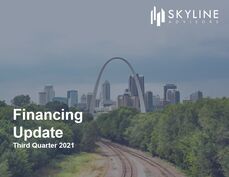 To receive the full 15-page report, please visit our Great Lakes page. National Data for Q1 of 2023 Mergers & Acquisitions M&A activity, based on deal counts, is expected to be relatively flat compared to the last two years; however, aggregate deal values are continuing a recent trend of decreasing. The average deal size is decreasing due to a combination of declining earnings multiples and buyers focusing more on sub-$100 million deals that carry lower multiples than larger deals. Reported valuation multiples dropped by approximately 14% in the first quarter. A large driver of this was less use of debt leverage by financial buyers. A higher than usual percentage of deals were all-equity and the use of debt leverage dropped by half during the quarter. Sellers are absorbing portion of the leverage gap through lower valuations while buyers are investing more equity. Growth Equity After accelerating growth investments from Q3 2020 through Q1 2022, private equity firms slowed their growth investments during the last four quarters. However, the combination of significant dry powder and lower valuations could lead to an up-tick in activity.  Download our Second Quarter 2022 Mergers & Acquisition Update Here M&A activity softened again in the second quarter, driven by a number of factors: geopolitical tension and warfare, continued inflation and supply chain issues, the worst first-half of a year for market performance since 1970, and rising interest rates. Roughly 4,570 North American deals were completed during the quarter, for a combined value of nearly $550 billion. Volume remains relatively high to historical levels, while overall value matched that of a 12-quarter average. On a positive note, valuation levels rebounded sharply from a weak first quarter. This is encouraging to see, as it suggests we’re not entering a firesale-type of environment and that buyers are still willing to pay up for quality companies. As we approach the end of the third quarter, we are hopeful that easing fuel prices and grain shipments commencing out of Ukraine will soften inflation, and we hope the market recovering from mid-June lows will increase investor confidence. Yet, we are acutely aware of the persisting challenges ahead.  Download our Second Quarter 2022 Financing Update Here Following a record quarter of deal volume, preliminary estimates show a decline in early-stage investing activity of 24.5%. Meanwhile, IPO fundraising has been a mere fraction of what we experienced in 2021, and stock markets, as a whole, are down this year, suffering the worst first-half of a year since 1970. This has been brought on by already-tight supply chains and the Russia-Ukraine war driving prices – and inflation – significantly higher. To combat inflation, the Fed has risen rates from near-zero in the first quarter to a range of 2.25-2.50% as of late July. More rate hikes are expected, and capital markets are showing hesitation to put money to work. Furthermore, banks are making it harder to borrow, raising lending standards and spreads on loaned funds. Despite the gloom and doom rhetoric, investors remain flush with cash, fundraising has been particularly strong during the quarter, and there remain sectors of growth to which investors are more than happy to deploy capital. As always, contact us if you would like to receive information about activity in your specific industry or geography, or if you would like to discuss options for your business. Download Our First Quarter 2022 Financing Update Here
Q1 capital market activity declined from the record-breaking levels of 2021 but was still historically high. In fact, PitchBook estimates that the first quarter may set a record in venture capital deal volume when factoring in deals that have not yet been reported. Growth equity investments were strong, early-stage investments generally had a dip, and IPO markets decreased more significantly. It has been well-known for a while that inflation was like to become a concern after the significant stimulus injected into the markets. However, the exacerbation of price increases by a variety of factors, including the Russia-Ukraine crisis, contributed to the potential market slowdown and volatility. It should be emphasized that investors are still flush with cash. Even if the final figures for Q1 do not exceed 2021 levels, the quarter’s deal volume was higher than the individual quarters of 2020 and prior years. With the Federal Reserve on track to raise its key interest rate a further six times in 2022, we will closely monitor how borrowing costs impact financing activity – particularly valuations. We also anticipate that we may see a shifting of investment activity between sectors as some become more out-of-favor while others become increasingly attractive. As always, contact us if you would like to receive information about activity in your specific industry or geography, or if you would like to discuss options for your business. Download our First Quarter 2022 Mergers & Acquisitions Update
M&A activity slowed in the first quarter, while valuations fell sharply. The volume decrease was generally expected as the buyers and investors we spoke with in Q4 generally indicated that they were in a full court press to close deals by year-end and weren’t building as much of a pipeline for Q1. However, for large deals, it may have also been exacerbated by Russia’s invasion of Ukraine and inflation concerns. The ongoing crisis has pushed commodity prices considerably higher. For example, wheat rose as much as 50%. The Federal Reserve is expected to make an additional six interest rate hikes after its first in March, which is expected to further slow investment. Nonetheless, from a historical perspective, first quarter activity was still relatively strong. More than 4,700 companies exchanged hands with a total value of more than $600 billion. And we’d be remiss if we didn’t note that investors are still flush with cash. Valuation levels overall fell sharply during Q1. While we anticipated a decline from historical highs, it was much sharper than expected. We anticipate that both deal volume and valuations may bounce back a bit in Q2 as buyers and investors have been replenishing their deal pipelines after the year-end rush. We have weathered a few highly uncertain years now, with new challenges arising at the start of 2022. While current trends are slightly concerning for overall M&A opportunities, we continue to believe there is significant demand for strong companies with favorable growth prospects. As always, contact us if you would like to receive information about activity in your specific industry or geography, or if you would like to discuss options for your business.  Download our Fourth Quarter 2021 Financing Update Here Strong economic fundamentals – strong balance sheets, low interest rates, and high financial returns – led to a record year for early-stage investing and initial public offerings. Venture capitalists (VC) raised $128.3 billion during the year, a 47.5% year-over-year increase, while investors were also recapitalized by an astounding $774.1 billion in liquidity from exiting investments. These factors, as well as the entry of nontraditional VC investors, contributed to the $329.6 billion that was invested in early-stage companies during the year. Private equity and other growth equity investment counts echoed venture capital activity, with a 50% increase in deal count in 2021. Meanwhile, nearly 400 IPOs raised a record $142 billion during the year. A record 27 companies raised at least $1 billion in their offerings.  Download our Fourth Quarter 2021 Mergers & Acquisitions Update 2021 was a record year for mergers and acquisitions, rebounding from a year in which portions of the economy essentially came to a halt. The 2021 economy was characterized by low borrowing costs, strong balance sheets, strong stock prices, and a surging economy, despite continued pressure from COVID-19, supply chain disruptions, and inflation concerns. The surging economy contributed to more than 18,500 deals crossing the finish line and more than $2.75 trillion in value consideration. Even the Midwest’s current-reported 148 deals is on pace to top the busiest quarter in five years.  Download our Third Quarter 2021 M&A Update Here M&A activity continues its record pace, supported by strong economic growth, borrower-friendly interest rates, and robust balance sheets. More than $1.8 trillion has been spent on North American M&A this year, topping $1.1 trillion and $1.6 trillion in the year-to-date periods of 2020 and 2019, respectively. While these factors may continue to drive activity in the near-term, the Federal Reserve will likely raise interest rates to counter inflation, which may hamper activity down the road. This may impact valuations more than deal volume as an increasing number of Baby Boomers plan to retire.  Download our Third Quarter 2021 Financing Update here. Record fundraising and exit activity are providing a boon for record U.S. venture capital investment. In fact, more capital has been deployed in each successive quarter thus far in 2021, and total spend is nearly double so far this year over the first three quarters of 2020. It continues to be an optimal time for early-stage companies looking to raise cash. Private equity and other growth equity investment counts in the U.S. increased 45% compared to the same quarter of 2020, while deployed capital increased 9%. Despite a dip in IPO activity, the market for IPOs is trending similarly to overall VC activity and is on pace for the best year since the tech-led boom of 2000.  Download our Second Quarter 2021 Financing Update here. Early-stage investors continued to deploy capital in record-breaking sums, with the $75 billion deployed in the second quarter matching the first quarter total. Despite a dip in transactions, transaction counts remain elevated from a historical perspective. It continues to be an optimal time for young companies looking to raise cash through equity investment. Similar to the record-breaking taking place in the venture capital world, activity for initial public offerings is also taking place at a rapid pace. In fact, the IPO market hasn’t been this hot since the Dot-Com era. Private equity deal volume decreased 5.2% compared to the first quarter of the year. |
Archives
May 2023
Categories
All
|
|
Skyline Advisors is a division of Ideation Ventures, Inc. Services involving securities are offered through M&A Securities Group, Inc.4151 N Mulberry Drive Suite 252, Kansas City, MO, 64116 (“MAS") . Services involving real estate brokerage are offered through Berkshire Hathaway HomeServices Ambassador Real Estate ("BHHS"). Skyline, MAS, and BHHS are separate entities.
COPYRIGHT 2024. ALL RIGHTS RESERVED. |

 RSS Feed
RSS Feed
